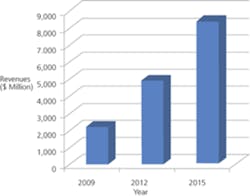Green Engineering Enables More Energy-Efficient Designs
The end of green engineering is nowhere in sight. Government regulations and incentives and, more importantly, consumer demand for increased product usability have been driving corporations to invest more and more into green engineering with the main objective of reducing the use of fossil fuels.
Mobile Phones and Other Hand-Held Products
While green engineering is a broad topic, the issue of battery life of hand-held consumer products such as smartphones and tablets has been front and center, mainly due to the number of people affected by the issue. Customers want longer battery life for their devices, and manufacturers are striving to meet this requirement.
One company helping engineers come up with better designs is the privately held Canadian firm EMSCAN, which specializes in very near-field measurement technologies. Its RFxpert product helps designers and wireless product developers optimize antenna performance. As its CEO Stephane Attal put it, “In the wireless world, a better performing antenna is one that uses less energy. Designing a better antenna will increase battery life and the usability of the product. That’s really important for consumer products like cell phones, netbooks, and book readers.”
Going forward, the increasing complexity of these devices is expected to further fuel the need to conserve power. Moreover, the much faster rate of technology change in semiconductors in comparison to battery technologies could increase the need for more power-efficient designs.
Solar Electronics Market: Revenue Forecasts
(North America), 2009 to 2015
A key challenge faced by engineers as a result of these trends is the design of amplifiers operating in the nonlinear regions. “Anritsu offers a nonlinear test solution based on the VectorStar Vector Network Analyzer family. This enables engineers to characterize nonlinear devices so that they can be optimally matched to maximize efficiency in their amplifier designs,” explained Bob Buxton, marketing manager, General-Purpose Business Unit at Anritsu.
Agilent Technologies also addresses this requirement with its PNA-X that can characterize nonlinear devices like amplifiers to do impedance matching. Along with some universities, the company developed the X-parameters that enable the characterization of not only linear but also nonlinear devices. “A key aspect of X-parameters is adjusting the DC power to the nonlinear device, giving engineers not only the ability to fine-tune their design for signal quality but also for low power consumption,” said Neil Forcier, application engineer for Agilent Technologies’ Systems Products Division.
Solar Power
The other hotspot for green engineering is the solar power industry. A great deal of innovation is going into devices that surround solar panels such as microinverters and DC optimizers in an effort to lower the cost per watt. “Materials development, such as the introduction of silicon carbide for power inverters, creates a need for gigahertz bandwidth measurement tools including mixed-signal oscilloscopes for complex system integration, such as the recently introduced Tektronix MSO 5000,” noted Dr. Kevin Ilcisin, CTO at Tektronix.
The solar power industry requires all kinds of device characterization instruments to better understand the efficiency of its designs. According to Celeste Jenkins, market development manager for Agilent Technologies’ Systems Products Division, “We are helping developers and manufacturers of solar cells and microinverters improve the efficiency and applicability of their products. For instance, we offer a solar simulator, the SAS, which makes it easier for engineers to replicate what a solar panel puts out and test all the devices that are downstream from solar panels.”


